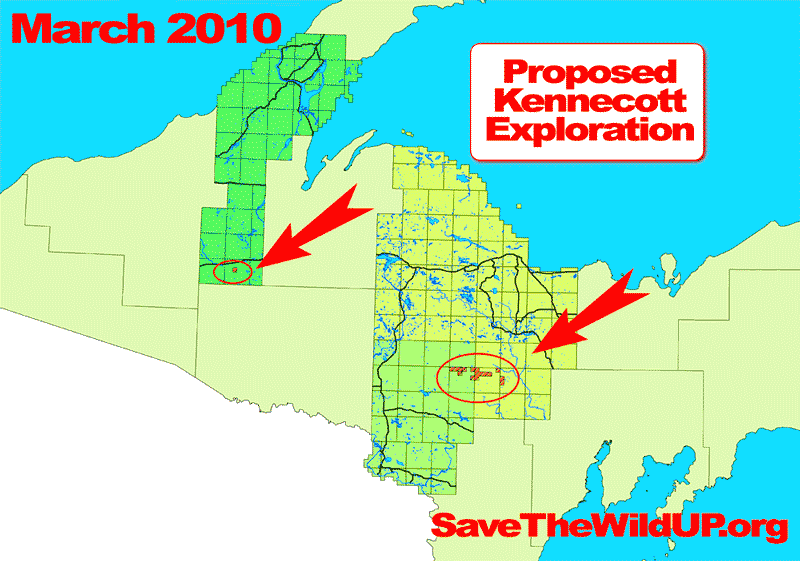But mining company spent more than $700,000 on U.P. uranium exploration in 2009
By Michigan Messenger’s: Eartha Jane Melzer 11/13/09 2:12 PM
http://michiganmessenger.com/30150/lawmakers-downplay-possibility-of-u-p-uranium-mining
Upper Peninsula lawmakers are railing against a ballot measure to create standards for uranium mining, claiming that no uranium ore has been discovered in Michigan. However, a Canadian uranium mining company says it’s found uranium in the U.P., scientists have warned that its uranium exploration could harm groundwater, and the Western Upper Peninsula Health Department is warning that residential wells in several counties already have elevated levels of the radioactive metal.
In a statement this week, Sen. Mike Prusi (D-Ishpeming), Sen. Jason Allen (R-Traverse City), Rep. Mike Lahti (D-Hancock), Rep. Steve Lindberg (D-Marquette) and Rep. Judy Nerat (D-Wallace) accused sponsors of a proposed 2010 ballot measure on mining of talking about uranium mining in order to scare people and destroy the mining industry.
“No ‘uranium mining’ activity has ever existed,” the lawmakers stated, “nor has any uranium ore been discovered, in our state.”
However, according to a July 2009 financial report from Bitterroot Resources Ltd., a 17-hole uranium exploration drilling program concluded last December “identified several areas which warrant additional exploration.” The company said it spent $717,403 on Michigan uranium exploration in the first nine months of 2009.
On the sections of the company website devoted to its Upper Peninsula uranium exploration Bitterroot states that early drilling “encountered a 0.6-metre interval containing 75 ppm U, including two 0.12-metre intervals containing more than 100 ppm U. These intervals are significant as they confirm that uranium-bearing fluids have been mobile within the Jacobsville Basin.”
The presence of uranium in this area is also known to local health officials. The Western Upper Peninsula Health Department has issued a uranium advisory.
“Scattered drinking water sources in the Western Upper Peninsula have been found to contain uranium in amounts that exceed the federal Maximum Contaminant Level,” the health department states. “The source of the uranium may be the shale deposits that run inconsistently through the Jacobsville Sandstone formation. Water supplies with radioactivity have been found in Baraga, Gogebic, Houghton, Keweenaw, and Ontonagon Counties.”
The department states that uranium-laced water may be associated with kidney damage and cancer and that people with wells constructed in the Jacobsville Sandstone formation should have their water tested for uranium.
Last year the National Forest Service granted permits for uranium exploration in the Ottawa National Forest and spokeswoman Lee Ann Atkinson told Michigan Messenger at the time that 50 test wells were authorized.
During the public comment period on this uranium exploration proposal by Trans Superior Resources, a subsidiary of Bitterroot Resources Ltd., Todd Warner, natural resources director for the Keweenaw Bay Indian Community, noted that the company’s plan to bury drill cuttings on Forest Service land could result in radioactive compounds leaching into area groundwater.
“If a uranium ore body is disturbed in its natural geological setting, radium and polonium will inevitably be released into our environment,” Warner wrote in comments entered into the record. “The Forest Service has not noted that any additional or added precautions or testing is being required due to the potential or likely presence of uranium, radium, polonium and other radioactive elements.”
Because of the risk of chemical reactions that can cause minerals to contaminate the water supply, metallic mining requires permits from the Michigan Department of Environmental Quality, said Hal Fitch, director of the agency’s Office of Geological Survey. But due to what Fitch called “a weakness in the statute,” exploratory mineral wells in the rocky western half of the Upper Peninsula are exempt from permit requirements.
In the case of the uranium test wells in the national forests, the DEQ will visit and observe operations after being voluntarily contacted by the mining company, Fitch said.
The Michigan Save Our Water Committee says U.P. lawmakers are mischaracterizing their proposed ballot initiative.
“We are not talking about banning future uranium mining,” said spokesman Duncan Campbell. “We don’t have any regulations covering uranium, all we are asking that we have some regulations to cover uranium.”
Read more!
Houghton Mining Gazette writer, Kurt Hauglie covers the issue:
http://www.mininggazette.com/page/content.detail/id/507472.html
Gail Griffith responds to Shawn Carlson Letter to Mining Journal Editor:
No U.P Uranium?
In a recent letter to the Mining Journal titled “No U.P. Uranium”, there is a statement: “There is no uranium ore anywhere in the state of Michigan.” The important word here is “ore”, which is defined as a naturally occurring material that can be profitably mined. This does not mean that there is no uranium in the state of Michigan. It means that no one has yet found of a profitable ore body.
The evidence for the presence of uranium in the U.P. is strong. The Western Upper Peninsula Health Department has issued an advisory for people with water wells in the Jacobsville sandstone formation in the Keweenaw Peninsula to have their water tested for uranium, because a 2003 study by a group at Michigan Tech found that about 25% of 300 wells tested in the area had levels of uranium above what is considered safe by the national Environmental Protection Agency.
Since 2003, Bitterroot Resources has been exploring for uranium in the Ottawa State Forest in the Jacobsville sandstone. In 2007, they found small amounts of uranium in drill cores. Cameco, a Canadian company that is one of the world’s biggest uranium suppliers, has given Bitterroot $1.7 million to do further exploration on the site. New drilling was done in 2008, and the results are now being evaluated for follow-up. Given that uranium prices have gone down from a peak of $140/lb. in 2004 to about $45/lb. today, even if this uranium body is large or rich, it may not be profitable now, but may well be later.
Mining for uranium is currently done by an process called in-situ leaching (ISL). This method does’t bring any ore to the surface, but rather pumps chemically-treated water into and through the ore body to dissolve the uranium and brings it to the surface, where it is extracted. Treated water is pumped back in to dissolve more uranium. The question is, where does the water come from, and where does it go?
Uranium deposits suitable for ISL are found in permeable sand or sandstone that must be protected above and below by impermeable rock, and which are below the water table. This means that if there is any connection or leakage into any other water source, that water will be contaminated with uranium. Further, the water used in the ISL process can’t be effectively restored to natural groundwater purity.
Michigan’s new Nonferrous Metallic Mineral Mining law.was written to deal with the threat of pollution by metallic sulfide ores and wastes that can create acidic, metal- laden water that must be carefully purified before being released into the environment. During the rule-making process, it was pointed out that uranium is a nonferrous metal, and could be mined under these rules, even though there were no provisions for the special precautions needed for radioactive materials. The response by the Michigan Department of Environmental Quality was that, yes, the “rules would apply to uranium mining, however, if uranium mining appears imminent, then the DEQ will review these rules for their adequacy to regulate such mining and determine revisions that may be needed”.
Part of the proposed MIWater Ballot Initiative language speaks to this issue by prohibiting uranium mining until new rules have been established. It is clear that such rules are needed now, and a vote for the initiative would ensure this. It’s all about our water.
Gail Griffith
Retired Professor of Chemistry
Northern Michigan University
No U.P. uranium
To the Journal editor:
We’ve all heard the arguments. “Michigan must preserve its proud mining heritage.” Then the counter: “Our environment must be protected from sulfide and uranium mining.” And so the tired argument trudges on, the latest installment of which being known as the MiWater Ballot Initiative. An argument with no clear victors, perhaps for good reason – both sides have some fair points: mining is a valuable industry, but the environment is important, too. If only there were a tie-breaker, something to tip the scales and guide the undecided. Well perhaps there is – the issue of education.
One of the goals of the MiWater Ballot Initiative is to restrict “uranium mining” in Michigan, in response to local activists’ proclamations that “uranium ore” has already been found and that mining could be imminent; one popular calendar says uranium mining has already been proposed and another Web site calls it planned. The problem is, none of that is true.
As contributor to the “Mineralogy of Michigan” textbook and recipient of the Friends of Mineralogy award for a study of Michigan uranium, I present my knowledge as authoritative, so here are the scientific facts.
There is no uranium ore anywhere in the state of Michigan. And since there is no uranium ore, there are neither proposed uranium mines, nor planned uranium mines; statements to the contrary are absurd.
Yes, there has been uranium exploration throughout Michigan since about 1949, but this work has found squat; in the words of one geologist, “If you took all of Michigan’s uranium and threw in 50 cents, you’d have enough to buy a cup of coffee.” Michigan simply lacks mineable uranium deposits, and the finest mineralogists alive today (e.g., George Robinson, Michigan Tech University) do not believe any will be found – ever.
One of the concerns of environmental activism is the lack of credible scientific information within these groups, as exposed in a recent Newsweek article (April 2008). And that’s a problem. At a time when the greatest questions facing us globally (climate change), nationally (energy independence) and locally (mining) all involve science, we owe it to our children to teach real science – not pseudoscience.
I therefore ask readers to oppose this new ballot initiative. Supporting it isn’t necessarily a vote to protect Michigan water; that remains to be seen. But it is a vote against the integrity of science education. And that’s unacceptable because it damages us all.
Shawn M. Carlson
Adjunct Instructor
Northern Michigan University
Marquette
 Recently the DNRE announced a public comment period for leasing over 4000 acres of mineral rights to Kennecott for further exploration. The exploration would take place in Southern Marquette County, Northern Dickinson County, and Southern Houghton County.
Recently the DNRE announced a public comment period for leasing over 4000 acres of mineral rights to Kennecott for further exploration. The exploration would take place in Southern Marquette County, Northern Dickinson County, and Southern Houghton County.
